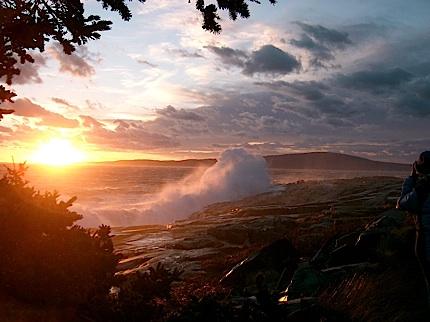Acadia National Park’s foundation was forged by the blueblooded families of Boston and New York, but its position among the ranks of national parks was driven by the passion of a man who fell in love with Mount Desert Island at an early age.
Today this Maine jewel welcomes all with a refreshing mix of forested mountains and ocean-pounded coasts that are among the country’s most iconic land- and seascapes. Acadia largely was born of a desire by the 20th century’s wealthiest East Coast families to protect bucolic summering grounds. But it was George B. Dorr, a Bostonian who visited the island in 1868 on a family vacation, who envisioned a national park here and saw it become a reality.

Beautiful cobblestone bridges carry Acadia's carriage paths over creeks and streams. NPS photo.
Today Acadia reflects “Down East” hospitality and architectural beauty. It is a park where you can relax in the Arcadian setting of Jordan Pond over tea and buttery popovers, take a horse-drawn carriage ride through the fragrant piney and mixed hardwood forests on John D. Rockefeller, Jr.’s leaf-covered carriage roads, climb a cliff, or paddle a sea kayak through Acadia’s powerful surging sweep of blue-green Atlantic swells.
The Atlantic Ocean is decidedly cold here, too cold for most swimmers, but along Acadia’s rocky shoreline you’ll find tide pools cupping lime-green sea urchins, bright red sea stars, and green anemones. Leave the shores behind while hiking to the park’s summit, 1,530-foot Cadillac Mountain, and you’ll gain panoramic views of Frenchman’s Bay, the Gulf of Maine, and the Atlantic itself.
Acadia visitors can typically face a dilemma on their very first day in the park. Should they hike, go to the beach, or pedal through the forests of Mount Desert Island? Hiking opportunities are plentiful enough that an entire vacation could be spent on the trails within park boundaries.

Check out Acadia's hiking options with a ranger. This is the Beech Cliff hike. NPS photo.
There are shorter paths that lead to gorgeous overlooks, long trails that wend their way up ridgelines to outstanding views (and even lemonade stands). And there are airy “trails” that scale rock faces, iron rung after iron rung, high above the sea.
The Insider's Acadia—Courtesy of Your Friends
Sound enticing? Here are some tips from Friends of Acadia on how to get the most out of your visit to this Maine jewel.
Board a boat. See Mount Desert Island as Samuel de Champlain did in 1604. Try the ranger-led cruise to Baker Island.
Park your car and walk. Take the village connector trails or ride the free Island Explorer shuttle into the park.

Hop on board the boat for the ride to Baker Islands. NPS photo.
Explore Acadia’s historic trail system, which includes engineering feats of granite steps and iron rungs.
Don’t miss Echo Lake. Its clear, refreshing waters are warmer than the ocean, and the swimming and kayaking are great. Come in June. The park is less crowded than during the height of summer and fall.
For more information and suggestions on how to enjoy Acadia, be sure to read the Traveler's guide to the park.




Add comment